19 books you should read this summer
Here are new works of fiction and non-fiction, recently published or upcoming, to engage and delight readers in the warmer months
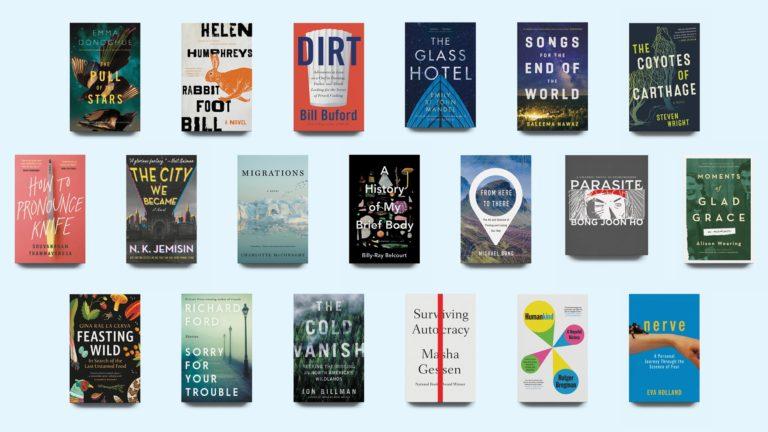
Share
 Rabbit Foot Bill, by Helen Humphreys (Aug. 18)
Rabbit Foot Bill, by Helen Humphreys (Aug. 18)
In 1947 in Canwood, Sask., 12-year-old Leonard Flint witnessed a murder, an act described by Humphreys in prose so quiet that the act simultaneously presents as shocking and mundane. In 1959, Flint—now a psychiatrist fresh out of med school and the untrustworthy narrator of this arresting novel—arrives at Weyburn Mental Hospital, 100 kilometres southeast of Regina. There he finds Machiavellian hospital head Luke Christiansen and the rest of his new colleagues committed to a dubious treatment protocol reliant on LSD, a drug they take themselves, the better to empathize with their patients.
Flint also finds at Weyburn—to his declared surprise—the killer, Rabbit Foot Bill, a local tramp he had idolized during his unhappy childhood years in Canwood. Flint, whose mental fragility is on a par with that of the patients in his care, immediately rekindles his obsession with Bill and neglects his other charges. By training and personal experience, the psychiatrist knows a lot about the stories people tell about themselves, and can sometimes see the contours of his own. Mid-novel, Flint pauses to tell whomever he imagines is paying attention that there was a happy-ending moment in his reunion with Bill, “if the story had only stopped there.” It doesn’t, of course. Flint’s obsession, its roots and the dangerous drug so easily available at Weyburn inexorably lead to tragedy. But also to resolution, by peeling off layers of personal and social secrecy stretching back to the Second World War, Helen Humphreys’ prime fictional landscape throughout her career.
Her explorations of the wartime setting helped make Humphreys one of the most popular literary novelists in Canada, and her readership has stayed with her since she began crafting her distinct hybrids, as she calls her newer mixtures of fiction, non-fiction and author’s intrusions. For the most part the seams, however tightly stitched, are clearly visible. In her biographical novel Machine Without Horses (2018), the first half consists of the author ruminating on how best to fictionally depict a life, with the second half featuring the result. This time, Humphreys does begin in familiar, “based-on-a-true-story” historical fiction territory. There really was such a murder in Canwood in 1947, and the man convicted was known as Rabbit Foot Bill. But on the whole, the story is more true to the fragile human mind than to history.
Weyburn itself, the place where the word “psychedelic” was coined, is only a ghostly presence, despite its role in the history of mental illness treatment in Canada. (In Rabbit Foot Bill, it mostly serves as a source of irony—every generation of psychiatrists evidently despises the practices of its predecessors—and humour: a circle of respectable fifties doctors on acid sound a lot like stoned undergrads circa 1971.) As well, in her concluding author’s note, Humphreys disavows any need to be “faithful” to the historical record. Her aim, she writes, was to adhere “to the memory of one Hugh Lafave,” referencing a prominent psychiatrist who was a superintendent at Weyburn, and before that, a Canwood boy who had known Rabbit Foot Bill. Whether that fidelity refers to Lafave’s recollection of events, when neither Flint nor Christiansen is a plausible stand-in for him, or to a kind of in memoriam tribute to his life’s work, is left unclear.
No matter. The ambiguities and uncertainties, paralleling Flint’s own, may mean a new level of hybridization for the author. But they make Rabbit Foot Bill all the more alluring for her readers, a quintessentially Humphreys story as beguiling as ever. — Brian Bethune
 The Pull of the Stars, by Emma Donoghue (July 21)
The Pull of the Stars, by Emma Donoghue (July 21)
Another pandemic book finished months before our current situation, Donoghue’s 11th novel takes place in a Dublin hospital during the deadly second wave of the Spanish Flu. Over three endless days as the Great War grinds to its end, nurse (and narrator) Julia Power, volunteer Bridie Sweeney and physician Kathleen Lynn (a real-life figure) profoundly affect one another’s lives as they struggle in a makeshift and flu-ravaged maternity ward. Donoghue, a first-rate historical novelist, skilfully weaves the era’ s primitive medical understanding and social prejudices into her moving story of three caregivers with little but loving care to give. — B.B.
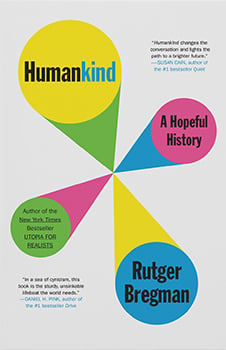 Humankind: A Hopeful History, by Rutger Bregman (Available)
Humankind: A Hopeful History, by Rutger Bregman (Available)
If there’s such a thing as a beach read for brainiacs, Humankind might be the one for socially-distanced 2020. Its hopeful message could not be better timed. On an epic quest for a solid answer to an eternal question, whether human nature “is essentially good or bad,” Dutch polymath, TED Talks wunderkind, and self-described “preacher’s kid” Rutger Bregman doesn’t struggle long before arriving at a decision. Bregman concludes that humans are “deeply inclined to be good to each other.” It’s how we’ve evolved.
Sensing that for a cynical, suspicious and fearful era, such a stance might seem counterintuitive (or sadly naive), he marshals an army of research findings as support. In essence, Bregman aligns himself with primatologist Frans de Waal, who coined the term “veneer theory” to describe an enduring but deeply flawed view of human nature associated with the 17th-century philosopher Thomas Hobbes—that our civilized behaviour amounts to “a cultural overlay, a thin veneer hiding an otherwise selfish and brutish nature.”
As Bregman turns adroitly from Neanderthal brains and Russian silver foxes to communal reactions to the Blitz of 1941, he returns to Hobbes/veneer theory on a regular basis. And as the pages of Humankind progress, Hobbes’ leviathan of a viewpoint takes on the appearance of cantankerous opinion rather than verifiable fact. Bregman never denies human darkness, only that it’s essential to our very nature. Cannily, he understands that any reader will immediately hold up any number of historical events that appear to prove we’re not deeply inclined to be good to each other; he revisits a couple handfuls, offering fresh ways to understand or interpret them.
Evidently an avid reader and researcher, Bregman skips from idea to idea—Machiavellianism, the Golem Effect, “pluralistic ignorance,” “‘broken windows’ theory”—while also touching on Dawkins’ selfish gene, Arendt’s “banality of evil,” Golding’s Lord of the Flies (not to mention jihadists, bullying, Donald Trump, Easter Island, oxytocin, Jane Goodall, Norwegian prisons, and many, many experiments using student volunteers or lab rats). It’s a dazzling performance.
As impressive as Bregman’s arguments are, he’s a gifted storyteller, transforming discussions of “contact hypothesis” and “extrinsic incentives bias” into riveting food for thought. Picture an animated, multi-directional lecture by a charismatic professor, and you’re at Humankind.
The argument now supported to his satisfaction, Bregman subsequently outlines a “new realism,” an approach for seeing ourselves as we truly are. And a final chapter, “Ten Rules to Live By,” gives readers some species-wide self-help. Though the seventh rule (“Avoid the News:” it “only skews your view of the world”) may rub many people the wrong way, others (including “Don’t Punch Nazis” and “Come Out of the Closet: Don’t Be Ashamed To Do Good”) have the merit of being buoyant and doable. “Cut yourself some slack,” Bregman seems to tell humanity. That’s welcome advice. — Brett Josef Grubisic
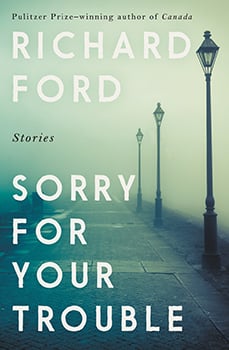 Sorry for Your Trouble, by Richard Ford (Available)
Sorry for Your Trouble, by Richard Ford (Available)
Ford is best known for his Frank Bascombe novels, whose elegant, inward narrative sprawl netted him a Pulitzer, among other prizes. So it’s surprising that he’s equally good, some would say better, at writing short stories, as well as at fiction’s oft-neglected middle child, the novella, both of which are represented in his latest collection. Sorry for Your Trouble finds the author, like the rest of us, in an elegiac mood: loss runs through these nine tales, with their casts of widows and widowers, of lawyers, dentists, and, yes, real estate agents, like a red thread. Emotional intelligence is as ever Ford’s tent-pole; he’s a master, especially, of dialogue’s slippery chemistry: its fleeting highs, misread signals and crashing lows. The stories here take place in Ireland, New York, New Orleans and Ford’s longtime place of residence, Maine (“Michigan with no sense of humour”). A highlight, “The Run of Yourself,” involves a man named Peter Boyce returning, two years after his wife’s death by suicide, to the seaside Maine town where they used to vacation, and where the longed-for reckoning is bedevilled by a series of unexpected incidents: sinister, rotten-toothed locals proffering fish; a realtor requesting to show Peter’s rented house to clients; a down-on-her-luck young woman who needs a place to spend the night. Yet it’s in exactly these disconnections and thwartings that Ford finds the quiet sense of tragedy, as well as the mitigating humour, that are the enduring hallmarks of his work. — Emily Donaldson
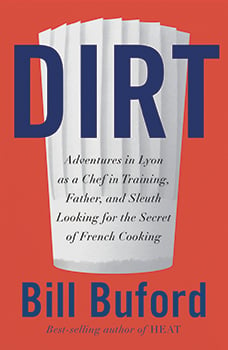 Dirt, by Bill Buford (Available)
Dirt, by Bill Buford (Available)
In his last memoir, the bestselling Heat, ex-literary editor Buford became a competent line cook in an Italian restaurant. Emboldened, for Dirt he uproots his family from New York to Lyon to talk his way into a job in a Michelin-starred kitchen. He also wants to test a theory that French cuisine owes its existence to cucina Italiana—thus guaranteeing he’ll enrage the locals.
Tense humour abounds as ex-literary editor Buford subjects himself to successive humiliations, eventually winning the right to work 80-hour weeks while his wife wrangles twin toddlers and studies to be a sommelière. As Buford perseveres, embedding himself for a book-advance-draining five years, his narrative transcends its fish-out-of-water premise. He digs into the violent history and peculiar social dynamics of the city at the heart of French gastronomy, and into the idealism its cuisine demands: since the German occupation, French cooking has become, more than ever, an affirmation of identity. It expresses a connection to terroir, or dirt—which is, of course, most fertile when it’s multilayered and rich.
Buford depicts Lyon’s restaurant scene at a crossroads, perhaps poised to embrace a redeeming diversity, but at risk from the forces of big agriculture and bigger money—as well as its own tendency to spit out those who don’t seem to fit in. It’s in his amusing, poignant portrayals of under-sung Lyonnais heroes—the eccentric ex-pat chef Michel Richard and the melancholic baker “Bob”—that Buford’s large, unruly book is at its best. “French food is built on making opposites work,” he tells us, and in Dirt, rather remarkably, he does just that. — Mike Doherty
 Songs for the End of the World, by Saleema Nawaz (Ebook available, print version Aug. 25)
Songs for the End of the World, by Saleema Nawaz (Ebook available, print version Aug. 25)
Half the initial attraction of Nawaz’s novel about a coronavirus pandemic—completed a year ago, months before the first news emerged from Wuhan—lies in comparing how well her fictional description of a fearful world’s response matches the real thing. (Short answer: very, very well.) But what keeps a reader scrolling the pages—the print version has kept to its long-scheduled August release date, but an e-book is available now—is that Songs is also a fine novel.
Through a half dozen intricately linked characters, the Montreal author explores up-to-the-minute issues in epidemiology, including elite panic—when the ruling class cracks down on unrest with the kind of repression that spurs rather than dampens violent upheaval—and the intense pressure to rush unproven treatments into use or to re-open economically too soon. The last two do unfold in Songs, to horrific effect, but in the end the centre does hold. Humanity in general, and Nawaz’s characters in particular, do not—for the most part—yield to panic and despair in an ultimately hopeful story about the fragility of human connection, and the lengths to which even ordinary people will go to keep it alive. — B.B.
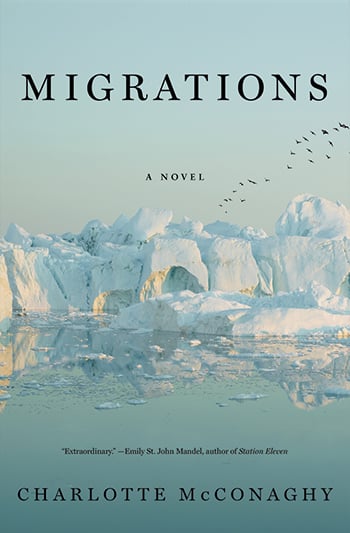 Migrations, by Charlotte McConaghy (Aug. 7)
Migrations, by Charlotte McConaghy (Aug. 7)
It’s the near future, and the Sixth Great Extinction is decimating wildlife. Franny Stone, who has always found balm for her losses in her love of birds, is obsessed by the thought of their extinction. She heads to Greenland to track the last flock of Arctic terns on what she believes will be their final migration to Antarctica. After she affixes tracking devices to three birds, Franny talks her way onto a desperate fishing boat, convincing the captain and crew of the Pequod-like Saghani that the terns will lead them to their own white whale, one last haul of disappearing fish. On the journey south, the secrets of Franny’s violence-shattered life emerge, one shard of memory at a time, in an exceptional novel that is both elegy and page-turning thriller. — B.B.
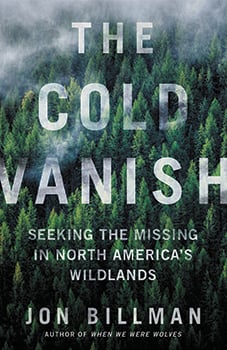 The Cold Vanish, by Jon Billman (July 7)
The Cold Vanish, by Jon Billman (July 7)
In April 2017, Jacob Gray abandoned his bicycle in Washington State’s Olympic National Park and vanished. The search for the 22-year-old forms the narrative spine of this compassionate and riveting non-fiction dive into wilderness disappearances. One of the many volunteer searchers involved, Billman became close with Gray’s father, Randy, a man willing to “liquidate his world in order to find his son.” The two scoured and re-scoured the park, the nearby river and then—in case Jacob had run away to a new life—went further afield, from Northern California to Vancouver Island. Everywhere, they encountered bureaucratic roadblocks, good-hearted psychics, conspiracy theorists pinning disappearances on alien or Bigfoot abductions, and dead ends—and other searchers crying out for information about their lost ones.
Although precise numbers are hard to find, the author writes, the “vanish-without-a-trace incidents happen a lot more than almost anyone thinks.” So, everywhere, too, are the families, stuck in a world shrunk to “two awful gerunds, missing and searching.” Billman, a short story author making his first foray into non-fiction, writes beautifully about the anguish of uncertainty, including the way it literally mirrors Alzheimer’s, where the vanished are still visible, but their loss just as mysterious. In the North American cases that Billman discusses, some families abandon the effort while some never flag. Randy Gray didn’t, right up until the day 16 months after his son vanished when marmot biologists found Jacob’s wallet halfway up a mountain 25 kilometres from where he had left his bike, and park rangers then recovered his remains.
Most of the lost are quickly found, but the “cold vanished” have varying fates: some walk out on their own many days later, others seem destined to be eternal enigmas, and even the eventually found leave tormenting questions. Jacob Gray still trails an enduring mystery behind him. Randy Gray no longer puzzles over the where of his son’s story but the why—what he could have been thinking to abandon his bike trip to march up the side of a mountain? If there’s a moral to Billman’s haunting story, it’s don’t go into the woods alone—it can be murderous for everyone. — B.B.
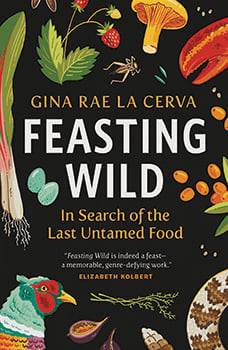 Feasting Wild, by Gina Rae La Serva (Available)
Feasting Wild, by Gina Rae La Serva (Available)
Towards the end of La Cerva’s debut—a sort of investigative, ruminating travelogue—she eats a foraged, hunted and farmed dinner with families in Borneo, and wonders, “Is this what Noma is trying to do?” For La Cerva, an American geographer and environmental anthropologist, the Copenhagen restaurant’s (pre-pandemic) super-high-end urban foraging is a prime example of how affluent societies construct “wildness:” as both natural and the ultimate in luxury.
La Cerva interrogates not only what it means to eat “wild” food but also the environmental, economic and societal impacts of doing so. With a fearless drive and a talent for tactile description, she treks through Poland’s remaining primeval forests, hunts moose in Sweden, follows the illegal game meat trade from DR Congo to Paris, and traces the multi-billion-dollar fetish for swiftlet birds’ nests to Borneo and Malaysia.
The book zings when she digs into historical context—for instance, into the roots of European conservation in the preservation of hunting grounds for royalty—as well as the issues of race, class, and gender that arise. Less compelling are the episodes when she herself becomes the story, and at times the writing feels overdone and her observations undercooked: “Our appetites—whether as rich tourist or poor refugee—have driven us around the world.”
Elsewhere, she’s perceptive. For instance, regarding zoonoses—diseases that travel from animal to human—why do we consider poultry and pork less risky than bushmeat? “Perhaps it simply comes down to racism.” There’s a lot to chew on here. — M.D.
 How to Pronounce Knife, by Souvankham Thammavongsa (Available)
How to Pronounce Knife, by Souvankham Thammavongsa (Available)
The characters in Thammavongsa’s debut short-fiction collection—many of who are, like her, Lao refugees living in Canada—hold typical newcomer jobs: they work in nail salons and factories, or as cleaners and labourers. But Thammavongsa, who’s also a poet, isn’t interested in a documentary-style literature of hardship. Instead, she elevates each of these spare, unflashy tales into something captivating and unpredictable. Often, generational roles are reversed, with children becoming their parents’ silent protectors. In the title story, a young girl decides not to correct her father’s hard-K pronunciation of “knife,” even after she’s briefly humiliated for it at school. In another, the narrator confesses: “I didn’t tell my mother they don’t wear uniforms in college here. I wanted her to have her dreams.”
In “Randy Travis” a man scrimps and saves so his wife can see her idol in concert. When they get there, however, they’re so far away that the singer’s face is “the size of a pin.” You can take that as a metaphor for minorities being relegated to the backseat of their adopted culture; and yet it’s also a rite of passage in that very culture: who hasn’t suffered the nosebleeds just to be in the presence of their hero? Over-interpret Thammavongsa at your own peril. She never panders or resorts to outsider clichés. At a factory Christmas party, the owner’s wife wears clothes “in fabric no one else’s clothes were made out of.” If that’s envy, the narrator’s not copping to it.
These characters might be at the bottom of the socio-economic ladder, but they find, and wield, power where they see it. In the final story—a miniature tour-de-force—a teen Lao girl, hoping to shake off a well-intentioned guy in her class who clearly likes her, gets him a job worm-picking with her and her mother, only to see him promoted to manager, a position he performs effortlessly, and with cold detachment. Her revenge comes when she refuses to answer her door the night of the school dance, reducing him to a pathetic, sobbing mess.
That spirit—doughty yet mischievous—runs through Knife, though it’s perhaps best captured by the two girls in “A Far Distant Thing,” who like to take turns pushing each other into an apartment garbage chute: “…not too hard. Just enough for us to feel the fear and then let it go.” — E.D.
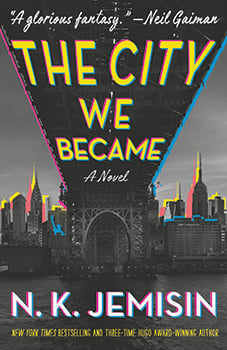 The City We Became, by N.K. Jemisin (Available)
The City We Became, by N.K. Jemisin (Available)
The epidemic that afflicts New Yorkers in this uncannily relevant novel doesn’t target their lungs; it turns them into bigots. In real life, as a Black woman writing celebrated speculative fiction (her previous three books, the Broken Earth trilogy, each won Hugo Awards), Jemisin has fought off abuse from the kind of alt-right “fascist dudebros” who, in The City We Became, are controlled by an alien presence that spawns wriggling tentacles everywhere. Jemisin retools the warped imagination of Cthulhu creator H.P. Lovecraft while repudiating his racism and xenophobia: a racially, socially diverse group of characters is called to save New York—one for each of the city’s five boroughs and a homeless, Black graffiti kid who’s New York’s “primary avatar.” Although the book’s urban weird fantasy recalls Brits Neil Gaiman and China Miéville, Jemisin, working with the stuff of American myth, makes her protagonists improbable superheroes. Their adversary often appears as a woman dressed all in white, of whom one sheltered character reflects, “Maybe she’s a Canadian who’s been driven mad by the cold and socialized medicine.” The boroughs need to find creative, prototypically New York “superpowers” to fight her—by battle-rapping, driving aggressively, and even literally throwing money. If the many-worlds theory Jemisin deploys to explain what’s happening feels a little tacked on, we’ll see how she develops it in later books in her “Great Cities” series. This first installment is a vital romp about resilience. — M.D.
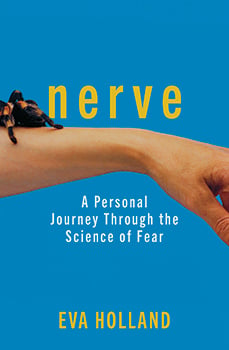 Nerve: Adventures in the Science of Fear, by Eva Holland (Available)
Nerve: Adventures in the Science of Fear, by Eva Holland (Available)
For much of her life, writes 38-year-old Holland, she had been afraid, in aspects of life both physical (heights) and social (making a wrong choice). But she never confronted those fears or considered fear as a human phenomenon, with evolutionary roots and biochemical expression, until the worst of them was realized. In 2015, Holland’s mother, whose life had been devastated by losing her own mother at age 10, died suddenly. It was Holland’s reaction—a deep sadness that would, at times, erupt into freeze-or-flee reactions, but which slowly abated—that sent the Whitehorse-based writer into researching the science of fear, including whether humans could actually smell it. We can, she found out, albeit unconsciously: our noses can’t distinguish the pheromone-caused differences between fear sweat and exertion sweat, but our brains can. The result, in those who smell fear around them, is a heightened attention to the immediate environment.
That engaging nugget, which shows how we can “catch” fear from others, is embedded in Holland’s account of her skyjumping experience, part of a courageous campaign to face her fears. The smooth interweaving of memoir and scientific exploration is what makes Nerve so compelling. And so reassuring: victory over fear is neither possible nor desirable, but, as Holland concludes, détente is. — B.B.
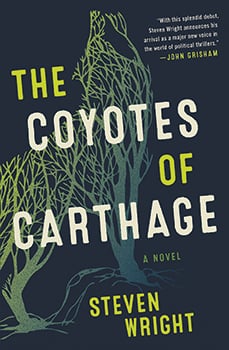 The Coyotes of Carthage, by Steven Wright (Available)
The Coyotes of Carthage, by Steven Wright (Available)
Crackling prose and a deeply cynical attitude make for an extraordinary novel from a former U.S. federal prosecutor. Political consultant Dre Ross is hired to manipulate Carthage County, S.C., voters into allowing miners to trash their rainforest. Dre has the dark money he needs for social media attacks—victory is “about getting voters to hate others,” he says—although the story turns on whether he still has the stomach for it. Wright simply eviscerates American politics in his entertaining thriller. — B.B.
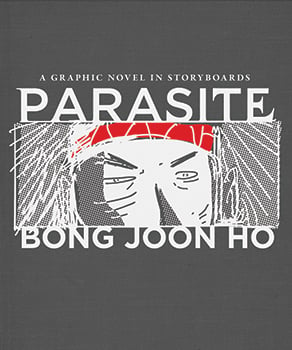 Parasite, by Bong Joon Ho (Available)
Parasite, by Bong Joon Ho (Available)
The director of the celebrated Oscar-winning movie caps his achievement with an extraordinary graphic work featuring his personally drawn storyboards. Bong never films without those precise boards, he writes—they assure him and his crew that the original vision is being followed. But spontaneity and creativity still erupt daily on the set, Bong admits, and fans already happy to be able to focus on just what he meant to convey in a scene can also catch fascinating “small differences” between boards and film. — B.B.
Memoirs
 A History of My Brief Body, by Billy-Ray Belcourt (Aug. 25)
A History of My Brief Body, by Billy-Ray Belcourt (Aug. 25)
Within this genre-blending work is an exquisite description of the “function” of a novel: “to whisper, to grab a reader by the throat with an invisible hand.” That’s why Belcourt—Driftpile Cree Nation member, winner of the Griffin Poetry Prize, Rhodes Scholar, 24 years old—prefers a poet’s approach. “My provocations will be bare-faced,” he writes, and so they are, beautifully shaped sentences that begin (but do not remain) in personal memory—his body, his queerness, his Native heritage—written with joy because “joy is art is an ethics of resistance.” — B.B.
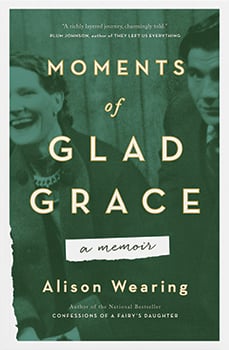 Moments of Glad Grace, by Alison Wearing (Available)
Moments of Glad Grace, by Alison Wearing (Available)
Wearing has written about her father before, in the bestselling—and equally witty—2013 memoir Confessions of a Fairy’s Daughter. Now, Joseph Wearing, on the cusp of his 80th birthday, is heading to Ireland for genealogical research, with his daughter as assistant, despite zero interest in the subject. There are raw moments of memory and clashing meaning, as in all family memoirs, but the prevailing tone is good-humoured, propelled by a sweetly expressed awareness of how brief a life we share with our loved ones. — B.B.
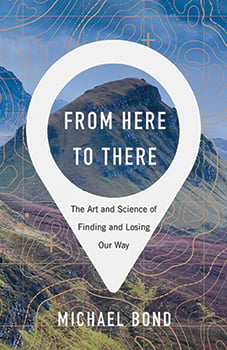 From Here to There: The Art and Science of Finding and Losing Our Way, by Michael Bond (Available)
From Here to There: The Art and Science of Finding and Losing Our Way, by Michael Bond (Available)
Humans are born to wander, or so argues this absorbing exploration of the intersection of neuroscience and geography. British science writer Michael Bond delves into all the quirks of our wanderlust, including statistically significant gender differences in giving directions, a descriptive “go past the church, turn left at the florist…” from women vs. the male “go two kilometres south then west for 500 metres.” The gender split explains why men do better on navigational tests than women do—such tests favour those who use math to orientate themselves—while women do better than men in remembering where objects are located.
The long-standing evolutionary explanation for this difference in finding our way—early homo sapiens males ranging far to hunt, females sticking close to home for foraging—no longer holds up, and researchers are increasingly inclined to a cultural explanation. Girls have never been allowed to roam as far or as freely as boys, limiting their chances to build the step-by-step mental maps that give children confidence in their directional sense. Studies show that eight-year-olds bussed to school are more inclined to display anxiety when away from home than those who walk to class. For that reason, experts Bond spoke with are alarmed by modern childhood’s shrinking range. (The author saves his most provocative issue for the epilogue, however: if the heavy lifting of cognitive mapping has been crucial to human life as we know it, just what is GPS technology, that ultimate shortcut, doing to us?)
Our mental maps are the primary reason humans manage to get anywhere, given how hopeless we are at dead reckoning. Lost without landmarks—in forest, fog or desert—it is impossible to avoid travelling in circles. Yet setting out blindly is what panic induces: a study of 800 search operations in Nova Scotia found only two lost people who had stayed put, one of them an 11-year-old boy who had taken a “Hug a Tree and Survive” course at school. Where the lay of the land is visible, though, we have always used its features to make mental maps through a series of specialized cells clustered in or around the brain’s hippocampus, including the boundary cells discovered in 2009. They perform the crucial function of indicating our distance and direction from an edge or a wall or even a change of colour or texture.
Our internal maps once found external expression as toponyms (descriptive place names). In the Arctic, Inuit toponyms handily beat British explorers’ place names as locators: Tallurutiup Imanga, “water surrounding land resembling facial tattoos on the chin,” versus Sir James Lancaster Sound. It takes a lot of effort and neurons to make those maps, but the more spatially engaged we are, researchers note, the more confident we feel about our literal—and metaphorical—place in the world. — B.B.
 Surviving Autocracy, by Masha Gessen (Available)
Surviving Autocracy, by Masha Gessen (Available)
Born in Moscow, Masha Gessen, 53, came to the United States when they—Gessen uses non-binary pronouns—were 14. A decade later, they were back in Russia, as a journalist, advocate for sexual minorities and prominent critic of the country’s slide into authoritarian rule under Vladimir Putin. Amid a rising tide of officially sanctioned homophobia, Gessen moved their family to New York in 2014. There, Gessen’s political focus soon turned to the rise of Donald Trump, a political figure they found far too similar to Putin. Two days after Trump’s 2016 election, Gessen’s essay “Autocracy: Rules for Survival” went viral. Now expanded to book length, it offers a unique perspective—the legacy of a Soviet childhood and stints of Putin- and Trump-watching—on what Gessen identifies as a rising tide of autocracy.
Gessen pays as much attention to Trump’s speech as his acts. And not just his words, but those of his enablers. One key feature of the autocratic style that the current U.S. administration and the old Soviet state share, Gessen writes, is “a monomaniacal focus on pleasing the leader, to make him appear unerring and all-powerful.” Trump himself has a “gift” for words in his ability to obliterate their true sense, Gessen adds. He has been aided in making political speech meaningless by an effectively complicit media committed to a neutral tone on any presidential statement. In the future, writes Gessen, journalists must openly acknowledge that media is inherently political: “To state directly what they are seeing, journalists will have to reveal where they stand.”
Trumpian language has inexorably corrupted American political discourse, in Gessen’s opinion, although not yet nearly as profoundly as “the century-long decimation of Russian [language] under totalitarianism and Putinism.” As a caravan of asylum seekers approached the southern border in 2018, with Trump’s rhetoric swirling about invasion and walls, even liberal media like MSBN were soon asking what could “deter” the caravan, using language from criminal law to discuss people with a legal right to seek asylum. “The circle of us,” the core of functioning politics, writes Gessen, continues to shrink in America. The coronavirus pandemic has reduced it further, with Trump and his allies more concerned with wealth than lives.
To reverse Trump’s aspirational autocracy, Gessen concludes in this sharply observed and passionate work, will require moral aspiration from Americans—a desire to make America a country of all its people. There’s no going back to a pre-Trump “normalcy.” The nation will need new politicians, new institutions and a new definition of what it means to be a democracy, “if that is indeed what we choose to be.” — B.B.
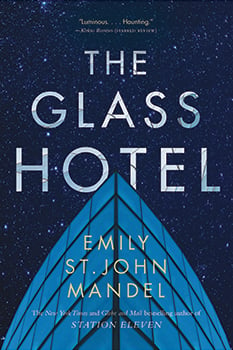 The Glass Hotel, by Emily St. John Mandel (Available)
The Glass Hotel, by Emily St. John Mandel (Available)
The words “Begin at the end,” and the thoughts of a woman named Vincent as she tumbles from an ocean freighter in 2018, open St. John Mandel’s exquisitely written fifth novel. (Vincent’s mother named her daughter after the American writer Edna St. Vincent Millay, whose appearance in an Emily St. John Mandel novel seems whimsically inevitable.) The multi-voice story—Mandel’s work, including 2014’s Station Eleven, shows an unusually nuanced gradation between major and minor characters—soon shifts its focus to a luxury hotel on Vancouver Island, a glass-walled financial tower in Manhattan and the 2008 financial crisis. There’s also an enormous Ponzi scheme, as obvious in retrospect as Bernie Madoff’s, along with crushed lives and curses involving swallowing broken glass.
Music and water have substantial presences in Mandel’s understated, prose because her characters drift, physically, emotionally and temporally. They swim through memories—reviewing but never questioning them—and new situations, puzzling over how they ended up living the lives they do. They are living proof, in an utterly absorbing story of weakness, greed and deceit, especially self-deceit, of what one them declares in courtroom testimony: “It’s possible to both know and not know something.” — B.B.